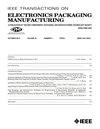Design for Environment: An Environmentally Conscious Analysis Model for Modular Design
IEEE Transactions on Electronics Packaging Manufacturing
Pub Date : 2009-07-10
DOI:10.1109/TEPM.2009.2022544
引用次数: 32
Abstract
Nowadays, more and more manufacturing enterprises are working hard to improve the environmental performance of their products. Pollution may be generated through the life cycle of a product. To maximally improve a product's overall environmental performance and reduce potential environmental impacts, Design for the Environment can be used as early as the design stage for the product. For electromechanical products, modular design is a widely used design method. While traditional modularity analysis pays little attention to environmental factors, this research aims at including comprehensive environmentally conscious criteria into modularity analysis. This paper presents a semi-quantitative environmentally conscious modular analysis model in order to reduce pollution. Eight criteria are identified to capture most of potential environmental impacts of modular products, some of which are fuzzy criteria. Fuzzy Analytic Hierarchy Process is used to rank these environmental criteria, and fuzzy numbers are used to map some uncertain judgments of decision makers with crisp numbers. Structure of a product is represented as a fuzzy graph. The proposed modularity analysis includes similarity analysis and independence analysis. In the end, an example is given to illustrate the developed methodology.面向环境的设计:模块化设计的环境意识分析模型
如今,越来越多的制造企业都在努力提高其产品的环保性能。污染可能在产品的整个生命周期中产生。为了最大限度地提高产品的整体环境性能并减少潜在的环境影响,环境设计可以早在产品的设计阶段就使用。对于机电产品而言,模块化设计是一种应用广泛的设计方法。传统的模块化分析很少考虑环境因素,而本研究旨在将综合的环境意识标准纳入模块化分析。为了减少污染,本文提出了一种半定量的环保意识模块化分析模型。确定了八个标准来捕捉模块化产品的大部分潜在环境影响,其中一些是模糊标准。利用模糊层次分析法对这些环境标准进行排序,并利用模糊数将决策者的一些不确定判断映射为清晰的数字。产品的结构用模糊图表示。本文提出的模块化分析包括相似性分析和独立性分析。最后,给出了一个实例来说明所开发的方法。
本文章由计算机程序翻译,如有差异,请以英文原文为准。
求助全文
约1分钟内获得全文
求助全文

 求助内容:
求助内容: 应助结果提醒方式:
应助结果提醒方式:


